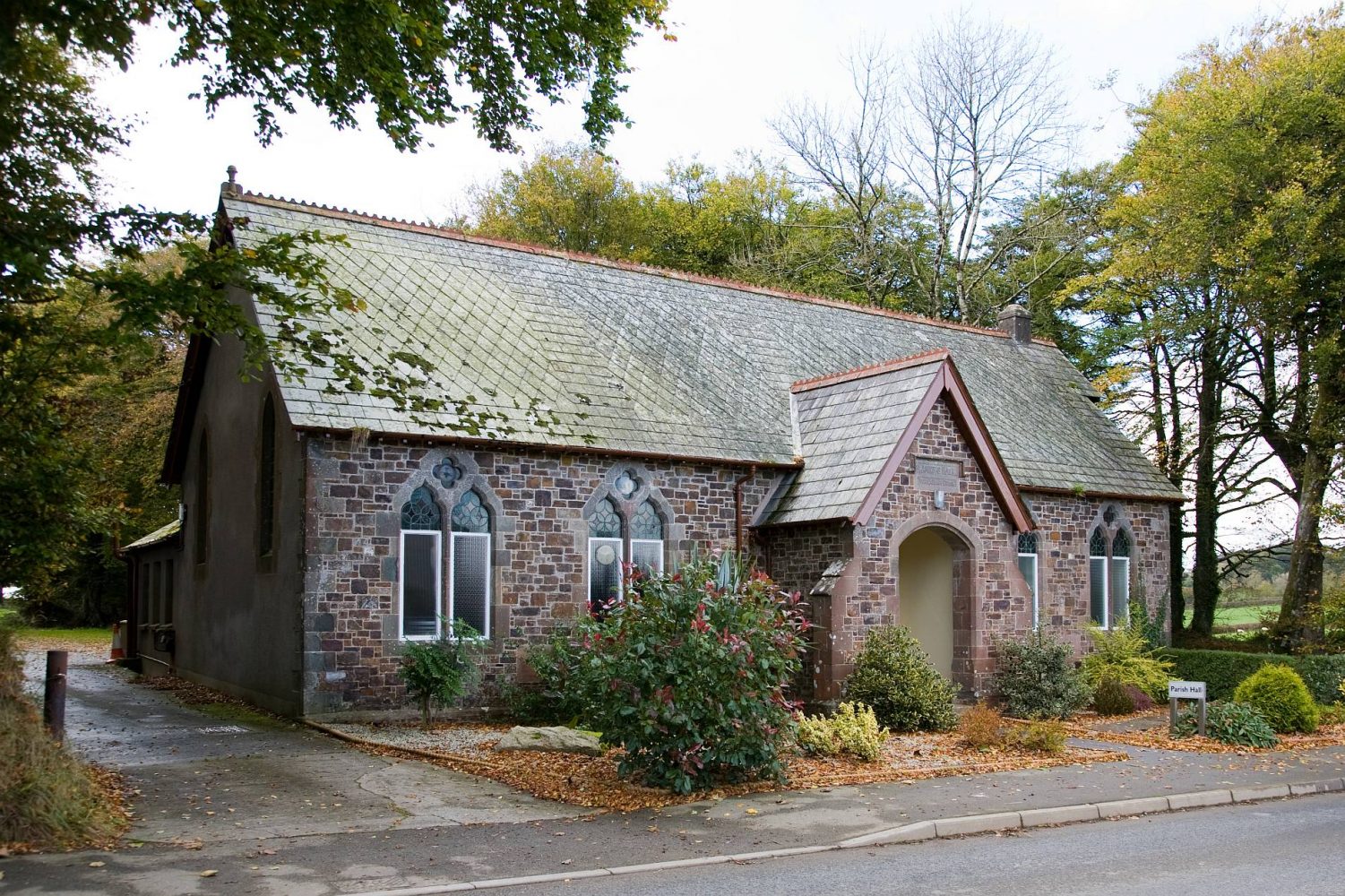History of Whitstone
Thanks go to ..
those involved in the Parish Plan for their hard work , as a lot of that information has been used here.
Population
Whitstone is a village of 582 inhabitants in 207 households in North Cornwall, lying on the B3254 mid way between Bude and Launceston.
The population contains well below the national average 18-30 year olds and correspondingly well above the national average of pension age residents.
The parish of Whitstone is bounded to the east by the river Tamar and the Devon county border, to the north Bridgerule, northwest Marhamchurch, southwest Week St Mary and southeast Boynton and North Tamerton.
The B3254 runs through the centre of the village while only classified as a B road it carries about 3000 vehicles per day of which 150 are HGV’s (based on the last traffic count which was outside the tourist season).
The main employment in the parish is Agriculture and agricultural services with construction and public sector employment (the two
sschools) roughly equal second, tourism and haulage are also important to the village.
Self employment is 3 times the national average.
Settlement Pattern
The settlement form is a central village with small farm hamlets around the parish. The main farm type is medieval farm settlements, often formerly hamlets but now typically a single farm Settlement outside the village is generally sparse.Vernacular buildings are varied with materials but are predominately slate roofs, slate hanging, cob and slate. Housing types are varied with Victorian houses, cottages, terraces or more modern semi-detached housing.
Whitstone village is the amalgamation of several local hamlets
- Whitstone surrounding the Norman Parish Church of St Anne
- Boot on the junction of the Holsworthy road and the B3254
- Street a collection of farm cottages stretching south to the Week St Mary road junction.
There are signs of early settlement in the tumuli at Foxhole and Dilland, whilst in the northern part of the parish are the defensive earthworks with single bank at Hilton Wood and Froxton. At the
turn of the century, the outlines of Froxton Castle, which covered an area of 160 feet by 145 feet, were less distinct than formerly, because of cultivation. The earthwork at Hilton Wood was oval, measuring 215 feet by 170 feet with a ramp of 14 feet and a ditch h of 12 feet deep, then in good order.
The Land and Geology
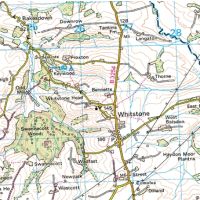 The majority of the area is the Carboniferous Crackington formation of shale, mudstones and inter-bedded sandstones. A band of Lower Carboniferous slates with thin limestone and shale runs north west/south east and appears to define and produce higher ridges and small isolated hills. Soils are shallow hard rock soils on higher ground to the north and alluvial soils in the valleys.
The majority of the area is the Carboniferous Crackington formation of shale, mudstones and inter-bedded sandstones. A band of Lower Carboniferous slates with thin limestone and shale runs north west/south east and appears to define and produce higher ridges and small isolated hills. Soils are shallow hard rock soils on higher ground to the north and alluvial soils in the valleys.
Land cover is dominated by farmed land of improved grassland/pasture with arable Woodland prominent in places, particularly in and around the valleys and is a mixture of broadleaved, coniferous and mixed woodland. Small areas of wetland and rough ground occur along the valleys. Pasture is the dominant land use both as dry permanent pasture on higher land and wet meadow pastures on the river floodplains.. The wet clay soils of the valleys and valley sides are influential in the distribution of pasture and arable land, and wetland habitats occur in many valley floors. Medieval enclosure is dominant with a significant proportion of post medieval enclosure, often on higher ground. Many of the coniferous woodland and mixed woodland plantations are managed commercially.
Domesday Book
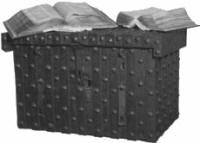 The earliest mention of the village is in the Domesday Book of 1086, when Whitstone was called ‘Witestan’, and thanks to William I, was held by Ralph from the Count of Mortain. The Witestan area, called a “hundred” was 12 acres, holding 8 cattle, 8 pigs, 40 sheep and 40 goats: from this time one of the houses in Whitstone still remains and is still inhabited. (Wikipedia)
The earliest mention of the village is in the Domesday Book of 1086, when Whitstone was called ‘Witestan’, and thanks to William I, was held by Ralph from the Count of Mortain. The Witestan area, called a “hundred” was 12 acres, holding 8 cattle, 8 pigs, 40 sheep and 40 goats: from this time one of the houses in Whitstone still remains and is still inhabited. (Wikipedia)
In the 19th century, the parish was called Whitstone. There were around 500 villagers, and the village had its own ‘Post Office’, and the entire parish comprised around 4,000 acres (16 km2), with part of the Bude Canal passing through the parish.
Mr Edward Mucklow a Lancashire born man who purchased about seven thousand acres of Land in Devon and Cornwall in the 1870’s and who had a home in Whitstone was a much respected ‘Squire’ and held in high esteem by his tenants and the local population.
Business and Economics
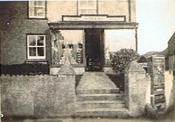 In 2006, the village had the most businesses it ever had. Over the last ten years or so, the village has grown and now has around nine businesses. Some of these are big nationally, some are just local and some are just known within the village, selling homemade items from home.
In 2006, the village had the most businesses it ever had. Over the last ten years or so, the village has grown and now has around nine businesses. Some of these are big nationally, some are just local and some are just known within the village, selling homemade items from home.
Whitstone Village Stores opened in the 1980s, and has changed hands a couple of times, with closures during the handovers. After a long closure, it was opened again in 1996 with a brand new interior. The shop has changed hands a number of times since then.
Anglican Church
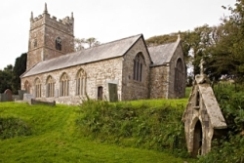 This pretty little church with its adjacent holy well claims for Patron St. Anne, although St Nicholas appears in official record as early as 1309. Of the Norman church two relics survive in the Norman font and the porch doorway, the latter of course, being not in its original position. The curious little window, or squint, communicating between the porch and south aisle is of great interest if of genuine antiquity, but its purpose is not easy to determine. As usual, the church was rebuilt in the 15th century and a western tower added to it.
This pretty little church with its adjacent holy well claims for Patron St. Anne, although St Nicholas appears in official record as early as 1309. Of the Norman church two relics survive in the Norman font and the porch doorway, the latter of course, being not in its original position. The curious little window, or squint, communicating between the porch and south aisle is of great interest if of genuine antiquity, but its purpose is not easy to determine. As usual, the church was rebuilt in the 15th century and a western tower added to it.
Richard Buvyle, rector of Whitstone, died in 1358, slain either by his own hand or “emulis suis”. He was doubtless buried at a cross-roads. Rumours had it that he was a saint, and some remarkable cures having taken place at his grave, the body was translated to the church. meanwhile the cult of this new saint had taken hold of all North Cornwall and Devonshire. Banks of people kept nightly vigils at the first place of his burial, saying prayers for his soul. These, with the friends who brought them victuals, converted the place into a regular fair, with the inevitable result of what Bishop Grandisson Called “Commessaciones ebrietates et conventicule inhoneste, illicita et nepharia que non decet exprimere”. The Bishop took a firm line. He ordered the cultus to cease until due enquiry into the alleged cures had been made. In 1361 a certificate of 10 cures performed on five men and five women was sent to him by a jury consisting of three vicars, three curates, and six laymen, specially summoned at Week St Mary for the purpose. Four were effected at the original grave and six in the church. They are certainly very remarkable, one being of a lunatic lady from Northam, who, being brought bound to the church, strove to lacerate the wax candles with her teeth and to throw down the images. Being, however, cured on the spot her protestant fury abated and her next visit to Whitstone was one of devout gratitude, pilgrimage and prayer. The matter, however, seems to have died a natural death, for we hear no more of it. In 1779 William Score, rector since 1736, reported to the Bishop “as to dissenters in my parish, there have been some disguised Papists as I am told who call themselves Methodists.” A Chapel of Holy Trinity was licensed in 1429, possibly an aisle in the church.
From Parochial history of Cornwall
The church has its own cemetery, but also has a separate cemetery for those people who do not attend the Church which was given to the village in 1926 by Mr S O Ham.
Methodist Chapel
 The Methodist Chapel is in the centre of the village, with a private car park on the opposite side of the road. The first Bible Christian chapel was opened at Boot in 1835. James Thorne preached on the foundation stone of the present church in 1863 and it was opened in the following year by Frederick W Bourne. Thorne was the leader of the Bible Christians through most of their ninety two year history, and Bourne for the last thirty years of the denomination.
The Methodist Chapel is in the centre of the village, with a private car park on the opposite side of the road. The first Bible Christian chapel was opened at Boot in 1835. James Thorne preached on the foundation stone of the present church in 1863 and it was opened in the following year by Frederick W Bourne. Thorne was the leader of the Bible Christians through most of their ninety two year history, and Bourne for the last thirty years of the denomination.
From Methodism in Cornwall
There was a bible Christian chapel in the village at Boot which was the old name for the centre of the village. The Bible Christain chapel, know as Ayres chapel closed many years ago it was used as the Methodist Sunday school until 1950’s and then was sold. A local builder JRJ Rees bought it and used it as a store for many years. After his death it was sold and a change of use applied for and it is now being converted into a house under private ownership.
Maggie Stanbury (2016)
St Anne’s Village Hall
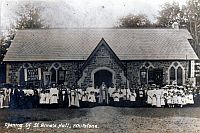 The Hall was dedicated to the memory of Rev. Robert Hawker Kingdon who was Rector of this parish for 44 years and who died at Christmas 1908. The foundation stone for the new Hall was laid by his grandson Robert C. Hawker Kingdon on 9th September 1909 and the building was officially opened on 9th September 1910 when there was a procession, led by a band, from the Rectory to the Hall followed by a High Tea. The original photograph of this event shows a large group of parishioners standing in front of the Hall in all their finery. An enlargement of this picture now hangs in pride of place in the main Hall.
The Hall was dedicated to the memory of Rev. Robert Hawker Kingdon who was Rector of this parish for 44 years and who died at Christmas 1908. The foundation stone for the new Hall was laid by his grandson Robert C. Hawker Kingdon on 9th September 1909 and the building was officially opened on 9th September 1910 when there was a procession, led by a band, from the Rectory to the Hall followed by a High Tea. The original photograph of this event shows a large group of parishioners standing in front of the Hall in all their finery. An enlargement of this picture now hangs in pride of place in the main Hall.
From a talk on the history of the hall given by Mervyn Collins on 9th September 2010
GenUKI
Higher Wadfast Farm
What’s in a name?
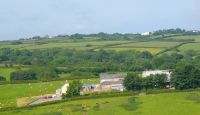 If anyone rings us and wants our address nine times out of ten they will ask ‘How do you spell Wadfast?’ Wadfast is an old Anglo Saxon name and was spelt Wadefeste in 1086. The Wade part either refers to someone’s name Wada or the English word wade meaning a ford. The second part fast meaning a stronghold or a secure place, thus the name either means the stronghold of a person called Wada or the stronghold of a ford. On an old map there were two fords, one at the bottom of the Hill opposite the Entrance to the woods and one further along our lane which leads to fields known as Waddons. Similarly Buckfast in Devon seems to mean the Bucks safe place. Lower Wadfast is mentioned as a Manor in the Doomsday Book, coming down the hill from the village known as Briskey Down or it’s former name Buskey Down there is a sycamore tree on the left hedge, but referring back to ‘Martyn’s Map’ 1748 this is roughly the position of the Old Manor House. The Doomsday entry records that it was held in 1086 by Hamelin from the Count; Siward held it before 1066, and paid tax for half of the land ( yes they paid taxes then!!) With land for 6 ploughs, 3 slaves, with 1 villagers and 5 smallholders. 15 acres of woodland, 100 acres of pasture. The value formerly was 20shillings with 8 cattle, 30 sheep, 6 pigs and 15 goats!! No intensive farming then! There is another settlement shown between Lower and Higher Wadfast until maps in 1748 but this does not appear on any later maps. On the RPA (Rural Payment Agency to give them their correct title, we could think of others!!) updated maps it shows a place of heritage status, an old settlement along Waddons Lane, it is easy to see the remains of two or three hedges there. In 3 of our fields it is possible to see this when the sun is at the right angle, or this winter, where the snow would melt first, shows the signs of the old Anglo -Saxon ploughing method known as Ridge and Furrow where it is possible to see slight inclines and indents in lines approximately 4 metres (13 feet in old money!) apart. Going across with a tractor at speed is a very bumpy ride. Obviously these fields have never been ploughed with a tractor pulled plough. This is by no means unique to Wadfast there must be a lot of fields showing the same characteristics, look out for them as you travel around the countryside. Has anyone else researched the history of their property?
If anyone rings us and wants our address nine times out of ten they will ask ‘How do you spell Wadfast?’ Wadfast is an old Anglo Saxon name and was spelt Wadefeste in 1086. The Wade part either refers to someone’s name Wada or the English word wade meaning a ford. The second part fast meaning a stronghold or a secure place, thus the name either means the stronghold of a person called Wada or the stronghold of a ford. On an old map there were two fords, one at the bottom of the Hill opposite the Entrance to the woods and one further along our lane which leads to fields known as Waddons. Similarly Buckfast in Devon seems to mean the Bucks safe place. Lower Wadfast is mentioned as a Manor in the Doomsday Book, coming down the hill from the village known as Briskey Down or it’s former name Buskey Down there is a sycamore tree on the left hedge, but referring back to ‘Martyn’s Map’ 1748 this is roughly the position of the Old Manor House. The Doomsday entry records that it was held in 1086 by Hamelin from the Count; Siward held it before 1066, and paid tax for half of the land ( yes they paid taxes then!!) With land for 6 ploughs, 3 slaves, with 1 villagers and 5 smallholders. 15 acres of woodland, 100 acres of pasture. The value formerly was 20shillings with 8 cattle, 30 sheep, 6 pigs and 15 goats!! No intensive farming then! There is another settlement shown between Lower and Higher Wadfast until maps in 1748 but this does not appear on any later maps. On the RPA (Rural Payment Agency to give them their correct title, we could think of others!!) updated maps it shows a place of heritage status, an old settlement along Waddons Lane, it is easy to see the remains of two or three hedges there. In 3 of our fields it is possible to see this when the sun is at the right angle, or this winter, where the snow would melt first, shows the signs of the old Anglo -Saxon ploughing method known as Ridge and Furrow where it is possible to see slight inclines and indents in lines approximately 4 metres (13 feet in old money!) apart. Going across with a tractor at speed is a very bumpy ride. Obviously these fields have never been ploughed with a tractor pulled plough. This is by no means unique to Wadfast there must be a lot of fields showing the same characteristics, look out for them as you travel around the countryside. Has anyone else researched the history of their property?
John Stanbury
Whitstone by F Audrey Hosier
Edited Extract from Old Cornwall Journal vol. 8 no 3 Aug1974:
A considerable stream, which flows into the river Tamar, is its border with North Tamerton and another stream, running through the woods of Swannacott and Wadfast on the Western side, marks its boundary with Week St Mary. The line then comes along a minor road to Bevil’s Hill and thence towards the Tamar, which divides Whitstone from Bridgerule. That the parish is well watered is apparent time and time again in the field names on the Tithe Map of 1839. For example, there are Great Marsh and Long Marsh on Lower Downrow; Wetland Meadow in Nethercott; Blacklake Marsh in old Nethercott; Wetleigh and Clayland in East Balsdon
Signs of early settlement appear in the tumuli at Foxhole and Dilland, whilst in the northern part of the parish are the defensive earthworks with single banks at Hilton Wood and Froxton. At the turn of the century, the outlines of Froxton Castle, which covered an area of 160 feet by 145, were less distinct than formerly, because of cultivation. The earthwork in Hilton Wood was oval, measuring 215 feet by 170, with a ramp of 14 feet and a ditch 12 feet deep, then in ood order.
Three manors are recorded in the Domesday Survey, two of which were held by the Count of Mortain; one of these was called Wadafeste, and it had been Siward’s in the time f King Edward.
There was one hide and it rendered geld for 1 ½ virgates. “Six teams can plough this. Hamelin holds this of the Count” Hamelin had one villein, five borders and three serfs, 8 beasts, 30 sheep, 6 swine and 15 goats. There were 15 acres of woodland and 100 acres of pasture, worth 20 shillings yearly. Torna (Thorn) was the Count’s other manor; it had been in the possession of Uleric who held one virgate, rendering geld for half that amount of land, which one team could plough.. Hamelin held Torna also, with a ferling in demesne; the villeins held the remaining land and 2 oxen. He had 3 bordars and one serf, 20 sheep and 4 goats; there were 20 acres of pasture, worth 2 shillings yearly. The 3rd Manor, Forchetestan, (Fprkstone) was held by Judhel de Totenais (Totnes). Previously it had belonged to Alward, but at this time Turstin the Sheriff held it from
Judhel. “Therein are 3 ferlings and it rendered geld for 1 ferling. Three teams can plough this. Therof Turstin has in demesne 1.2 a ferling and ½ a plough and the villeins have the remaining land. There Turstin has 2 bordars and 4 serfs and 8 beasts and 12 swine, 40 acres od wood, 50 acres of pasture. It is worth 11 shillings and when Judhel received t, 15 shillings.”
Geld – a tax paid to the crown.
Virgate – a measure of land approximately 30 acres.
Demense – grounds belonging to the manor.
Villein – a person who owed certain services or rent to the Lord in return for their land.
In the 19th century, the parish was called Whitstone. There were around 500 villagers, and the village had its own ‘Post Office’, and the entire parish comprised around 4,000 acres (16 km2), with part of the Bude Canal passing through the parish.
Mr Edward Mucklow a Lancashire born man who purchased about seven thousand acres of Land in Devon and Cornwall in the 1870’s and who had a home in Whitstone was a much respected ‘Squire’ and held in high esteem by his tenants and the local population.
Wadfast appears on the modern map of Whitstone as the name of a wood And of two farms, Higher Wadfast and Lower Wadfast on the site of the manor house. In 1429, Thomas Halfacre and Agnes his mother and household had a licence for Mass in their chapel of Holy Trinity in Whystone. According to Gilbert, the property belonged in the time of Edward lll to the family of L’Anglois or Emglish and then to the Courtenays, Earls of Devon. It passed from them to the Grenvilles, for Norden calls it the “seat of Geo Grenville Esq.” In 1620 it was held in moieties between Hurdye and Pierce, who transferred it to the Rolles, from whom Lord de Dunstanville bought it; he was the owner in 1820. At the time of the 1851 census Lower Wadfast was farmed by Samuel Bines, employing two men and a boy for its two hundred acres. It was a place of some note and has been called “The Garden of Whitstone”. At a recent sale, Wadfast Moor made “20,000.
In the documents of Tonacom be, there is a reference to Thorne, in the parish of Whitstone, in November 1621 a nd again in 1646, when John Wadden of Tonacom be and Honour, his wife (the daughter and sole heir of Kempthorne als Ley, were in possession. In November 1673, Thorn in Whitson with other lands was to be held for life by Mary Coke, widow, of Truro, at a yearly rental of £120. Two years later, Thomas Wadden conveyed various lands in Whitston to John his son, upon his marriage to Mary: the property was to be entailed on the issue of John and Mary, with portions of “2.000 for any younger children. In 1700, Henry Badcock of Whitstone leased to John Gayer, Gentleman of Thorne for £5 and in 1727 or 1728, Thorne was sold according to the will of Thomas Wadden, to discharge his debts and legacies. At the time of the Tithe Adjustment in 1839, part of Thorne was owned by the Rev. Ponsford Cann, rector of Virginstow and occupied by Daniel D Badcock, who had a fir plantation there: of his 2 hundred acres, four were marshlands, four were taken by roads and wastes. Two fields were called Flack Hay and West Flack Hay: the word “hay” occurs more frequently on the Devon bank of the Tamar, where it signifies a hedge or an enclosure and so, a farm. A further eighty acres were owned by G W Owen Esq. and occupied by D D Bakler: a still smaller part – just over thirty acres – known as Down End Ham, was in the possession of John Gilbert. In the 1851 census, there were two farms known as Thorn and a brick burner was among those living in the area.
The third of the Domesday manors, now known as Froxton, was recorded as Forkedestone in 1250. In the time of Edward ll, it was the property of the Giffards and afterwards passed through heiresses to the families of Downe, Roose and Spoure. In Rodd documents of 1676, the Manor of Forkeston was part of the marriage settlement after the wedding of Edmund Spoure and Mary, one of the daughters of James Rodd of the City of Exeter: her portion was £1.600. The house is illustrated in the Spoure Book, according to Mr Charles Henderson and John Roose Esq. of Forkstone is mentioned also: according to Gilbert, the Roose family became extinct at Whitstone in the mid-sixteenth century and the heiress married Spoure of Trebartha. In Whitstone church there is a large stone monument to “ Magdelene Spoure, daughter of Richard Spoure of Trebartha Esq.: who was buried the 15th day of April AD 1687” From the B3254 the largest house that can be seen is Bennetts, an imposing building of red brick set on rising land and with a wall of similar material surrounding its garden. Gilbert says “the house is modern, but has nothing about it to claim particular attention” In the earlier dwelling lived the Hele family: there is a monument to two of them in the church. The Arms of Hele are shown quartering those of Warwick and Gilbert and the inscription reads “Here lyeth the body of Geo Hele of Bennetts Esq. who was buried 10th day of March 1652. Here lyeth also the body of Warwick Hele Esq. his eldest son, who was buried 4th day Jan 1650”. By 1821 Bennetts was the property and occasional residence of Lord de Dunstanville, whose ancestor had become possessed of it in the late seventeenth century by marriage with the Hele Heiress. Here in 1839, there was a fir plantation and coppice of more than fifteen acres, which accounted for some part of the annual payment to the Rector in lieu of tithe.
Whitstone Whistler October 2004
Wadfast Manor in the 1500’s
The following information was kindly provided by Maureen Adams and relates to the Sandercocks of Wadfast Manor.
‘Cornwall Manorial Rentals and Surveys’ Stoate
Manors of Marchioness of Dorset – 1525
Tenants at Will
Wadfast (in Whitstone)
John Sawnedercocke, William his son and Joan wife of the said William hold there for the term of their lives etc. according to the customs of the manor by grant from the aforesaid surveyors the site of the manor to which belongs 108 ½ acres of which 30 are arable, 30 are moor and 38 ½ are pasture worth each year 12d. And 10 acres are meadow worth each yearly 2/-.
There belongs also to the said site pasture in all the lady’s wood there called Wadfast Wood which contains 120 acres. And they give for a fine £6. 13. 4 and for confirmation £3. 6. 8. payable in three accounts and they pay yearly for all £3. 0. 8.
Thomas Saundercocke holds there by grant from John Gilbard and confirmation from John Fitzarberd one tenement to which belong 14 acres of land of which 4 are arable and 8 are pasture worth each 12d and 2 acres are meadow worth yearly 4/-. And he pays yearly for all 10/-
John Saundercocke holds there two small closes containing one acre of pasture land and pays yearly 2/-
Cornwall Subsidies in the reign of Henry VIII
‘…gives the person’d assessment on wages (W), Goods (G), or lands (L)’, (which ever was the greatest)
Sandercock Warbstow 1525 none
William Saundercock 1543 G 2
Thomas Sondercock Whitstone 1525 G 3
John Sondercock 1525 G 2
William Sondercock 1525 G 2
John Sandercock 1543 G 4
Margaret Sandercock 1543 G 1
William Sandercock 1543 G 6
Richard Sandercock 1543 G 1
No other Sandercocks recorded in Cornwall.
Muster Roll
Muster Rolls were lists of able-bodied men between the ages of sixteen and sixty who were capable of fighting, and their weapons or other assets that could be called on in times of warfare.
Muster Roll 1569
Parish Whitstone
Muster location Whyston
Name Degory Sandercock
Weaponry bow 4 arr
Name William Sandercoke
(No other information given)
Parish Warbstow
Muster location Warbstow
Name William Sandercock
Weaponry bow 4 arr
